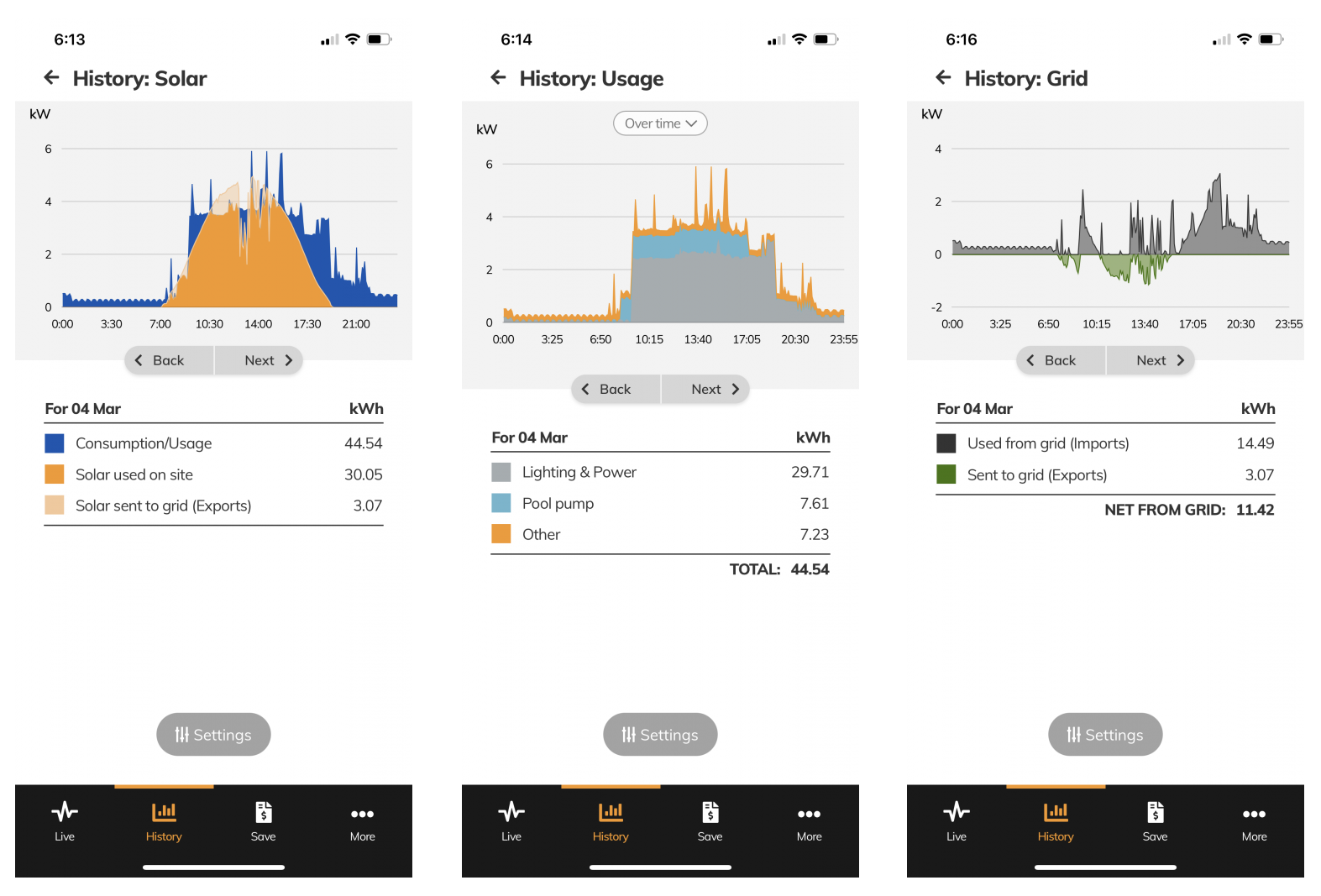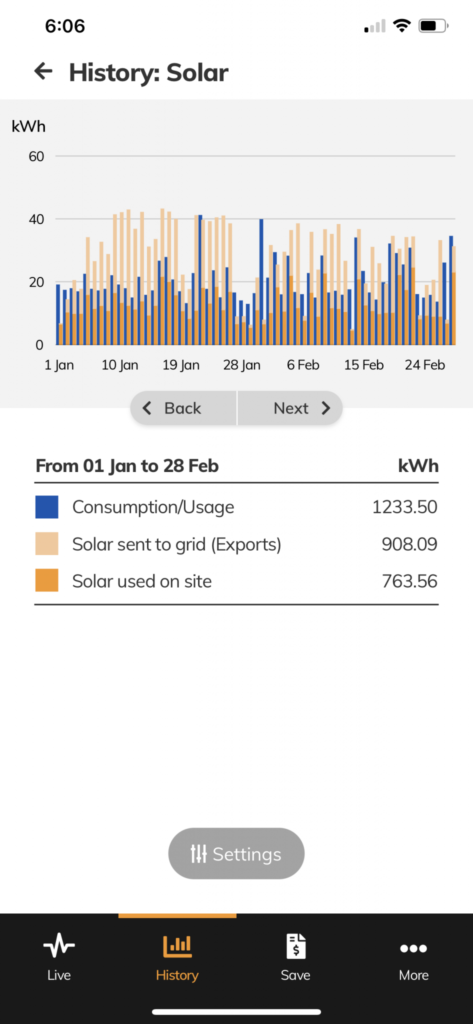This article was originally posted on Wattwatchers. Reproduced here with permission.

Reviewing a monthly electricity bill for 2021 has confirmed to me that so-called ‘smart meters’ are a failing technology. It makes me wonder how many people are disadvantaged by a lack of accurate data about their electricity consumption and patterns of use? Good thing my family has an app for that (hint: you can have one too)!
My family had a big year for energy last year, 2020.
We changed electricity suppliers, reduced household occupancy by a third, invested in rooftop solar, had a major LED lighting upgrade done, acquired an electric vehicle, and refinanced to a special clean energy home loan.
Thanks to Covid-19, we also spent a lot more time at home than previously, particularly work-time during daylight hours.
Along with the solar system, we had a new digital ‘smart meter’ installed by our energy retailer (the electricity grid rules require this).
Based on that meter’s readings, reflected in our monthly utility bills, it looks like we’ve done extraordinarily well as a family in terms of cutting our electricity consumption, saving money, and living more sustainably.
We have done well too, just not how the bill presents it. In fact, the picture painted by the January-February 2021 electricity bill is highly misleading. It significantly undersells our real achievements.
I don’t blame the power company itself for this. The real problem is flaws in the wider electricity system. It’s no longer fit for purpose as grids become increasingly distributed and digital.
So I won’t name the company. It’s a small, progressive, community-minded energy retailer that I admire a lot. I feel sure they’d want to do better if the ‘Power of Choice’ metering requirements for the National Electricity Market (NEM) guided them to inform their customers more accurately and comprehensively.
Here are some numbers
Let me break down the problem.
Based on a review of our electricity bills, in the past 12 months our household has gone from daily average consumption of 17.59 kilowatt hours (kWh), costing us $5.91 per day, to 7.9 kWh, costing us $1.86 per day.
Stellar, right? That’s average daily consumption down by 55.09% and the average daily cost of electricity down by 68.53% – which is equivalent to paying less than half the cost of a takeaway coffee each day.
The problem, however, is that both commonsense observation and my Wattwatchers smart energy monitoring device with the mydata.energy app tell me a different, yet in many ways even better story.
For a start, our average daily consumption of electricity has actually increased to 20.77 kWh, not fallen to 7.9 kWh, a rise of 18% versus the fall of 55.09% suggested by the utility bill.
We’ve added a major new electrical load to the household in the shape of an electric vehicle. It’s a Nissan Leaf with a 40kWh-capacity battery, which we top up with our solar electrons by trickle-charging from a standard power point whenever the car is at home and the sun is out.

March 4, 2021, was an EV-charging day for our home with total consumption of 44.54kWh in the 24 hours, for a household that our official power bill says averages only 7.9kWh of usage per day. Most of the action was ‘behind the meter’, with our rooftop solar supplying 30.05kWh, or 67.47% of the total, and the grid only 14.49kWh (32.53%). Our solar saved us $7.18 compared with what we would have paid to import from the grid the same amount we self-consumed, plus the very modest 3.07kWh we exported to the grid earned us 36.84 cents in bill offsets against on-bill charges of $3.46 for the 14.49kWh we imported. (SOURCES: Wattwatchers’ mydata.energy app + bill)
So what’s going on?
It’s simple. The utility ‘smart meter’ the NEM rules required once we had solar installed has serious limitations. The biggest is that it only ‘sees’ our rooftop PV system’s renewable energy generation as anything that is exported to the grid. That’s not very smart, as I am sure many electricity consumers will agree.
Thus it’s blind to total generation from the system, and can’t record our home-generated electrons that we use on site daily to cut costs and live more sustainably.
Thus the true picture at our house is beyond the visibility and understanding of the power company and the whole electricity system because of the technical limitations of the ‘smart meter’.
In a country where nearly a quarter of households now have rooftop solar, official energy metering policy and practice is becoming a national joke.
Of course we did make a substantial investment in installing the 6.6kW solar system, opting for high-quality panels and a premium inverter system. Even so, on my back-of-the-envelope calculations it will pay itself off in less than two-and-a-half years; and should operate for many years after that.
Counting the savings
The savings for us come from three main areas:
- No cost for electricity we generate on-site from our solar system and consume in the home on loads like the pool pump, dishwasher, clothes washing machine and electric vehicle charging
- An admittedly modest cost offset for clean electricity that we feed into the grid from our solar, and
- Diesel fuel costs we now avoid because we have an electric vehicle.
Our actual power bill is now acceptably small – circa $60 a month, of which about half is the mandatory network connection charge (91 cents a day to have the security blanket back-up of the main grid, which I welcome).
This means that for our home, installing an expensive home energy storage system makes no financial sense. (I’m not convinced it makes environmental sense either, given the materials and chemicals used in making batteries.)
But on this I’m certain. Everyone can benefit by having better data showing how their household uses electricity, and in the case of solar generates it too, before making any further investments in home energy assets.

If you look at the first two months of electricity use by our household for 2021, covering a total of 59 days across January and February, you can see our summertime solar bounty. Our total consumption of 1233.50kWh was more than matched by 1671.65kWh of solar generation, of which we used 763.56kWh on site and exported 908.09kWh to the grid. Apart from anything else, this means that our household is not only zero greenhouse gas emissions for electricity, but we actually have a positive ledger for our climate action contribution. The 469.94kWh that we imported from the grid – electricity mainly generated from coal-fired power stations – is more than compensated for by our 908.09kWh in solar sent to the grid. So some of our near neighbours also are getting cleaner energy thanks to our investment in rooftop solar. (SOURCE: Wattwatchers’ mydata.energy app)
Takeaways
- ‘Smart meters’ and the electricity bills created from the data they are capable of collecting can be very misleading for consumers, especially those with rooftop solar.
- Rooftop solar can be a very good investment that pays itself off quickly, gives you more ‘agency’ in meeting your electricity needs, and delivers greener-living as well.
- Even if you don’t have solar (yet), better data can help you and your household to be more energy efficient, to buy at the best tariff plan for you, and to plan future investments such as solar PV, solar + battery, electric vehicle and energy-saving appliances.
- Managing your electricity well is not a set-and-forget exercise, because I can see clearly how our scenario can change over time, including seasonal changes, and factors like the pandemic retreating and our household’s behaviours shifting back to less time at home.
- Electricity system rule-makers need to rethink the whole approach to metering and data acquisition to empower consumers with data-driven solutions based on a true picture of how they engage with energy.
FOOTNOTE: One more little whinge. Our bill purports to compare our consumption to other households in our area to benchmark our performance. It tells us that: ‘Your average usage is compared to households in your area with no gas mains connected and no pool. For more on energy efficiency visit www.energymadeeasy.gov.au.’ The only thing is, we are mains gas connected, and we do have a pool, but how would our power company know that if it can’t even ‘see’ our true solar productivity?
————————————–
About our Guest Author
 |
Part of the Wattwatchers founding team, Murray Hogarth is a sustainability strategist, stakeholder engagement specialist and communicator. His diverse experience includes nearly a decade consulting internationally with boutique sustainable business strategy firm Ecos Corporation, a 1990s startup; and a 21-year award-winning career in print and television journalism. Murray was Environmental Editor of The Sydney Morning Herald (1997-99), which included covering the landmark Kyoto climate change summit, and a reporter on the Australian Broadcasting Corporation’s flagship current affairs television programs, 7.30 and Four Corners (1990-95). A keen blogger, Murray is the author of two books on environmental themes.
You can find Murray on LinkedIn here. |


Don’t need a battery, just V2G instead 😉
The right data to make decisions is hard. Converting the data to action is even harder. Pretty hard to do with only 30 minutely data from the connection point. Often only for yesterday too.
I can’t see any comparable EV to the ICE paying for itself at double the price when you can go all electric with solar panels and with a solar diverter controller use the power to heat a storage HWS and any left over to aircondition the home for the homecoming. Solar panels are relatively cheap and so are electric element HWSs so lithium batteries aren’t in the race for energy storage.
As for V2G you go right ahead and pay for larger longer range batteries than you really need for transport if you feel the charitable urge to help stabilize the grid. As a BMW exec was asked when will EV prices come down he responded ‘never never never’ as they can make an ICE car for the price of a battery pack with its BMS. As a consequence any fuel cost savings with an EV is eaten up by the interest on borrowing as nearly 9 out of 10 do with car purchases.
What a thought-provoking article! 🌟 It really highlights the struggles many of us face with “smart meters” and how misleading the data can be. It’s frustrating to see our energy-saving efforts not reflected in our bills! 😩 I love how you pointed out the importance of having accurate data, especially for those of us with rooftop solar panels. 🌞 It’s essential for making informed decisions and maximizing our sustainability efforts. Let’s hope energy companies take note and start improving their systems! ⚡️ Keep spreading awareness! 🙌